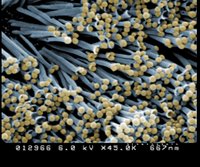| Technorati Tags: Nanofibers or Nanotubes and Nano or Nanotechnology and nanoparticles or Nanotech and Nanopore or nanochemistry and nanoscale or nanowires and nanogenerators or nano test tubes and Biotechnology or aldehyde chemical group and nanostructures or Nanoscience | Posts that contain "Nanotechnology" per day for the last 30 days. |
World’s tiniest test tubes get teensiest corks, Filed under Research, Health, Sciences on Wednesday, May 10, 2006.
 | Rows of tiny nano test tubes rest on a mesh in this electron microscope photo, shot in October of last year and colorized for added clarity. Seeking to deliver drugs within the body, |
GAINESVILLE, Fla. — Now all they need is a really, really small corkscrew.
Like Lilliputian chemists, scientists have found a way to “cork” infinitesimally small nano test tubes. The goal is a better way to deliver drugs, for example, for cancer treatment. Scientists want to fill the teeny tubes with drugs and inject them into the body, where they will seek diseased or cancerous cells, uncork and spill their therapeutic contents in the right place.
“After making the nano test tubes, we saw the potential for them to be used for drug delivery vehicles, but because they are open at one end it would be like trying to ship wine in a bottle without a cork,” said University of Florida, chemistry professor Charles Martin. “You have to cork it, which is what we have accomplished.”
Martin is one of six University of Florida chemistry faculty members and graduate students who co-authored a paper about the research that appeared last month in the Journal of the American Chemical Society.
While chemotherapy works against many cancers, it can cause severe side effects such as nausea, temporary hair loss and blood disease. To make the chemo hit only the cancerous cells, Martin and scientists elsewhere have spent recent years experimenting with drug-carrying nanotubes or nanoparticles.
“Nano” stems from nanotechnology, the fast-growing science of making objects or devices that approach molecular dimensions. One nanometer equals one-billionth of a meter.
The approach makes sense for attacking diseased cells while bypassing healthy ones, but it also poses challenges. For one thing, the nanotubes must recognize their target, a problem scientists are attacking by tweaking their chemistry to make it respond to the unique chemistry of cancer cells. The tubes also must be biologically benign. Martin says a method for making nanotubes he pioneered, template synthesis, allows manufacturers to use biodegradable material, such as the polylactides that compose biodegradable sutures.
Additionally, the tubes also had to be closed at one end to form the classic test tube shape, a problem Martin and his group solved in research published in 2004.
To “cork” the test tubes in the latest research, the researchers applied an amino chemical group to the mouth of the tubes and an aldehyde chemical group to the corks. The two groups are complementary, so they bond with one another.
Billions of nanotubes could fit on a postage stamp. So, said Martin, “we don’t put individual caps in each nanotube the way corking machines do for bottles.”
Instead, the scientists immerse a small mesh that holds millions of amino-modified nanotubes, all precisely lined up in a grid pattern, into a solution imbued with millions of the corks. Brownian motion — what happens when minute particles immersed in a fluid move about randomly — takes care of the rest. The corks simply float around, then slip into the mouths of the tubes as they encounter them.
The diameter of the tubes is about 80 nanometers, or 80-billionths of a meter. Even though they are tiny, each tube can hold about 5 million drug molecules. “Each tube packs a real punch in terms of the number of drug molecules it can deliver,” Martin said.
Sang Bok Lee, an assistant professor of chemistry and biochemistry at the University of Maryland, works on similar research. He said scientists have proposed capping the tubes using chemical interactions between the drugs and the tubes. But that might not work because the tube could leak before it reaches its target.
“I strongly agree that Professor Martin’s proposed strategy will be one of the ideal solutions for the problem of controlling drug uptake and release,” he said in an e-mail.
The UF scientists aren’t there yet. There’s no easy way to unlock the amino chemical group from the aldehyde chemical group. So while Martin says there are some promising possibilities, he and his colleagues have their next job cut out for them: figuring out how to uncork the tubes. -30-
Credits: Writer, Aaron Hoover, ahoover@ufl.edu, (352) 392-0186, Source: Charles Martin, crmartin@chem.ufl.edu, (352) 392-8205
Related: Keyword Nanotech Sunday, Sunday, May 07, 2006 Blood-Compatible Nanoscale Materials Possible Using Heparin, Sunday, April 30, 2006 Micro-pump is cool idea for future computer chips, Sunday, April 16, 2006 Self-Powered Nanoscale Devices, Sunday, April 09, 2006 Nanopore Method Genome Sequencing, Sunday, April 02, 2006 Quantum dot method rapidly identifies bacteria, March 26, 2006 'Custom' nanoparticles, cancer diagnosis and treatment, Sunday, March 26, 2006, Green nanochemistry, American Chemical Society symposium, Sunday, March 19, 2006 nanotechnologists demonstrate artificial muscles powered by highly energetic fuels, Sunday, Sunday, March 12, 2006 magnetic phenomenon may improve RAM memories, February 26, 2006 Nanoscience study shows that quantum dots 'talk', Sunday, February 26, 2006 Nano-bots to undertake major tasks?, Sunday, February 19, 2006 Nanotech to improve health care delivery, Sunday, February 19, 2006 nano-canary in the nanotoxicology coalmine, Sunday, December 04, 2005 Nano-cages 'fill up' with hydrogen, Sunday, November 13, 2005 Testing toxicity of nanomaterials, Sunday, October 23, 2005 single-molecule car, 'Nanocar', Sunday, August 28, 2005 Writing at the nanoscale, Thursday, May 26, 2005 discontinuous palladium, siloxane self-assembled monolayer, Sunday, May 08, 2005 Center for Nanoscale Materials, Monday, April 25, 2005 Nanomagnets, Nanocomposite, Monday, March 21, 2005 porphyrin tubes may lead to new nanodevices, inexpensive hydrogen fuel.











No comments:
Post a Comment